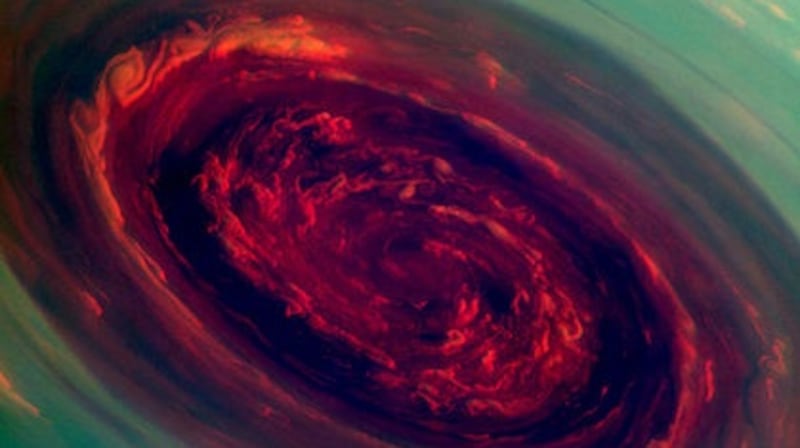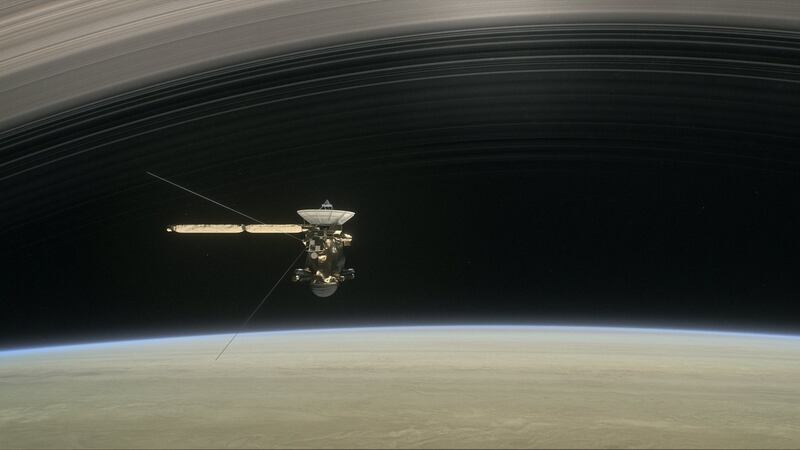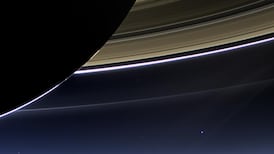After an interplanetary voyage that included flybys of Earth, Venus, and Jupiter, the Cassini spacecraft arrived at Saturn in 2004. Since then, from the discovery of seven new Saturnian moons to the imaging of the planet's hexagonal north-pole cloud pattern, the unmanned mission has amassed a huge number of achievements, earning its team a place in the history of exploration.
In addition to its immense contribution to the science of space, it has prompted much awe following transmission of images back to Earth. "If you want some escapism, Cassini is taking some stunning pictures around Saturn at the moment. We live in a beautiful universe," the noted science communicator Prof Brian Cox tweeted in January.
But over the past year Cassini has been making a number of close flybys between the planet and its inner rings in what is being termed the "Grand Finale". The spacecraft, which was launched in 1997 and arrived at Saturn seven years later, is now coming to the end of its life because of its diminishing fuel supply. On September 15th it will enter Saturn's atmosphere for the first time, and burn up into nothing, in a controlled destruction.


"Cassini has accomplished an incredible amount during its mission, providing a huge amount of new information about Saturn," says Prof Denise Gabuzda, senior lecturer at the department of physics, University College Cork.
"The results which I find most impressive concern the fundamentally new data that Cassini has provided about the moons of Saturn," she says, " revealing them to be fascinating worlds in their own right."
The Saturnian moons
In 2005 Cassini delivered the European Space Agency's Huygens probe onto the surface of Saturn's largest moon, Titan. This was the first ever probe to land on another planet's moon, and the data provided by both Cassini and Huygens showed that Titan is in many ways Earth-like: host to an atmosphere, oceans and rain.
"The observations of Titan, which include those of the Huygens lander, revealed a landscape with mountains, plains, lakes and seas," says Prof Andy Shearer at the Centre for Astronomy, NUI Galway.
“Although this does sound Earth-like, the temperatures are very low and the seas and lakes are composed of liquid methane and ethane. But Titan might resemble conditions on the primordial Earth.”
On another one of Saturn's 62 known moons, Enceladus, Cassini found evidence of hydrothermal activity, indicated by geysers.
Shearer says that “the discovery of water geysers associated with cracks on the surface of Enceladus suggests there is likely to be a warm ocean about 10 kilometres deep, below the thick coating of ice.” One intriguing question is whether there could be life there?
“All of these fascinating results for Titan and Enceladus were completely unexpected,” says Gabuzda, “and some of the chemistry occurring on Titan may be related to processes on Earth, before life emerged.”
Beyond ‘Cassini’ and into the future
Cassini's experience exploring Saturn and its moons has shown us what can be learned by sending unmanned spacecraft out into the solar system. It has also jolted our imagination into thinking about what else might be out there, and is yet to be discovered.
"Like all good space missions, Cassini-Huygens generated more questions than it answered," says Shearer, "A new mission to Saturn will be needed."
He also points out that Mercury, the closest planet to the Sun, is still largely unexplored. “It’s very difficult to get there and any probe will have to survive the intense solar heat, which is hot enough to melt lead,” he says.
Other contemporary missions that are already studying different worlds in our solar system include the Juno spacecraft, currently orbiting Jupiter, and the New Horizons probe which took astounding images of Pluto during its 2015 flyby, and will go on to observe some of the Kuiper belt objects over the coming decade.
But what about exploring planets beyond our own solar system – the so called exoplanets?
“As fascinating as the idea of visiting planets orbiting around other stars may seem, it will be extremely difficult,” says Gabuzda. This is because of the huge distances to even the closest stars. As an example she points out it would take light more than four years to travel from our solar system to the nearest star, Alpha Centauri.
“Some ideas for such long-distance travel involve large space lasers fired from Earth to accelerate and stop probes,” says Shearer. “Other possibilities include nano-technology, essentially building a fleet of very small space ships.”
“So to travel to the nearest star will essentially need a new science,” he says. “But for now there are still fascinating worlds to explore in our own solar system.”
Ireland’s role in space exploration
Ireland has been a member of the European Space Agency (ESA) since 1975 and has made contributions to many ESA missions over the years.
"A recent example of Ireland's activity in the space sector is the Herschel Space Observatory, " says UCC's Prof Denise Gabuzda. "The observatory studied a wide range of objects located both here in the solar system and in distant extragalactic space."
“There’s also the Planck mission,” she adds, “which was aimed at studying the earliest light emitted in the Universe – the Cosmic Microwave Background.”
According to NUIG's Prof Andy Shearer, "the Cassini spacecraft had fairly little Irish involvement, however one company, CAPTEC, validated the software used on the Huygens lander."
Irish scientists and industry experts are also involved in the ESA’s Solar Orbiter mission which is expected to be launched in February 2019, and will be tasked with observing the Sun. “Any space mission has a huge number of components that must be designed and constructed,” says Gabuzda, “which means there will be many opportunities for Irish high-tech companies, engineers and scientists in the future.”
Conor Purcell is a science and nature writer with a PhD in Earth Science – some of his other articles at cppurcell.tumblr.com
@ConorPPurcell










